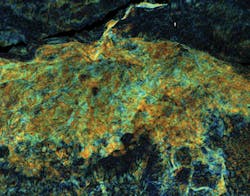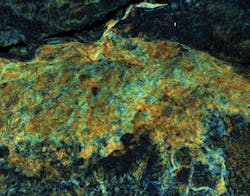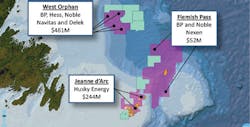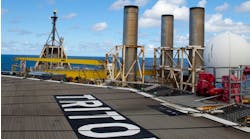Newfoundland and Labrador groups striving to unlock region's offshore potential
Kristann Templeton
Special Correspondent
Newfoundland and Labrador is Canada’s youngest province, a land steeped in history with an enduring connection to the sea. More than 500 years after explorers brought European settlers to its shores with the promise of waters “teeming with fish,” the ocean continues to provide a living for many of its half a million residents.
In the early 1990s, the cod fishery, once a mainstay of the province’s economy, underwent a steep decline and ultimate moratorium. This, however, marked a turning point for Newfoundland and Labrador, with the birth of a new industry: oil and gas.
Offshore exploration in the province dates back to 1966 when the first two wells were drilled on the Grand Banks - an area southeast of the island of Newfoundland on the North American continental shelf. Continued exploration revealed the province’s oil and gas potential, culminating in 1979 in the giant Hibernia field discovery.
Almost 40 years later, Newfoundland and Labrador has three producing offshore fields - Hibernia, Terra Nova, and White Rose - all in the Jeanne d’Arc basin area of the Grand Banks. A fourth, Hebron, will begin producing from the basin later in 2017. Other projects such as the Hibernia Southern Extension, White Rose South Extension, and proposed West White Rose Extension should extend the productive lives of these fields well into the future.
However, attention has now shifted to slope and deepwater areas. Statoil made the world’s largest conventional oil find (by volume) in 2013 in the Flemish Pass basin. The Bay du Nord discovery, estimated to contain about 300 MMbbl of recoverable oil, was the company’s third in the basin, following Mizzen and Harpoon. This basin, with water depths of 500-1,500 m (1,640-4,921 ft), is adjacent to the Jeanne d’Arc basin, some 400 km (248 mi) east of the province’s capital city, St. John’s.
Last June at the Newfoundland and Labrador Oil and Gas Industries Association (NOIA) annual conference in St. John’s, Ørjan Birkeland, vice president Exploration Canada, Statoil Canada, reported that the company had just completed nine wells (six exploration and three appraisal wells) during 19 months of continuous drilling in the Flemish Pass. This led to oil discoveries in two of the wells drilled close to Bay du Nord on the Bay de Verde and the Baccalieu prospects. Birkeland indicated that Statoil was encouraged by the new discoveries and the results of the appraisal wells. Based on an improved understanding of the petroleum system, he added, the company is maturing further prospects that may add volumes to reserves in the Bay du Nord area.
Exploration strategy
While the oil industry has been established in the province for almost 20 years, by many estimates it is still in its early stage of development. However, various exploration initiatives should help to unleash the province’s future potential.
Until recently, little was known about the seabed offshore Newfoundland and Labrador. Its total offshore sedimentary basin, covering an area of about 1.5 million sq km (0.58 million sq mi), is one and a half times the size of the US Gulf of Mexico, yet it has been sparsely explored, with only one well drilled for every 5,652 sq km (2,182 sq mi). Historic seismic data is also limited, and most of what was available was either acquired using old technology or focused solely on and around the Jeanne d’Arc basin.
The province of Newfoundland and Labrador and Nalcor Energy, the province’s state energy company, are making strategic investments to help the industry make the most of the opportunity ahead. Crucial policy barriers have been removed, improving international competitiveness and encouraging new investment, while newly acquired frontier geoscience data are offering early and exciting insights into the vast, underexplored offshore region.
Dr. Richard Wright, Nalcor’s manager of Exploration, explained that the biggest challenge to understanding the region’s resource potential is evaluating prospectivity. Since 70% of the region’s seismic data had been acquired prior to 1985 when technology was much less advanced, Nalcor saw a need to revisit some areas and at the same time take a more detailed look at other frontier regions.
Using insights from a regional Nalcor-Airbus satellite seeps survey and gravity and magnetics data, Nalcor, in partnership with TGS and PGS, has conducted one of the world’s largest offshore seismic programs. By the end of 2016, the partnership had acquired more than 145,000 line km (90,100 mi) of new 2D multi-client data off Labrador and down the southeast coast over the Orphan basin, Flemish Pass, Flemish Cap, and South Coast: large portions of these regions had never been imaged before.
This work has resulted in a doubling of the estimated basin area offshore Labrador; identification of three new deepwater basins (Chidley, Holton, and Henley); and an increase in size for the previously established Hawke basin. Under the ongoing program, new slope and deepwater areas are also being surveyed for the first time.
West Orphan play trend
Last June Nalcor announced the discovery of a new play trend in the West Orphan basin, a slope and deepwater area 300 km (186 mi) offshore Newfoundland. “Through leading-edge science we have identified a new Lower Tertiary play trend in the West Orphan basin containing material scale prospects with analogues to successful global producing regions,” Wright told an international audience at the NOIA conference.
The discovery followed several years of data acquisition and analysis. In 2015, Nalcor invested in a multibeam bathymetry and seabed coring survey, conducted by MG3 and AGI, targeting areas for upcoming frontier license rounds. Wright said the data acquired have enhanced the understanding of seabed conditions and rock types and bathymetry in frontier regions, resulting in better and safer decisions for future exploration programs. This latest work showed positive correlations between hydrocarbon indications in the seabed coring and the location of subsurface prospects.
To date more than 50 leads and prospects have been mapped in this area, with a seismic anomaly detected at the historical continental slope base, suggestive of a Lower Tertiary aged turbidite fan system, in 1,300 m (4,265 ft) of water and roughly 3,200 m (10,499 ft) subsurface. Nalcor continued work with TGS and PGS in 2013 to acquire a large scale 4,600-sq km (1,776-sq mi) 3D seismic survey over this area. The survey provided immediate new insights on the geology.
One of the key deepwater prospects identified in this area is Cape Freels, named after the closest point of land on the island of Newfoundland. The play trend contains geology similar to slope and deepwater regions offshore Brazil. Cape Freels appears to share characteristics with Brazil’s Marlim field, which has undergone significant development success.
“We continue to model various scenarios, from gas over water to oil over water to various geological effects that could be causing this,” Wright explained, “to determine the scenarios that best match the field data. Very often, the more you know about an area, the less it looks prospective, and indeed we will have many of these areas across our Newfoundland and Labrador offshore. However, in this play trend, every step of the process has seen risk reduced.”
He stressed that 3D seismic, in particular, has led to important insights on trap geometry and potential hydrocarbon systems. “The risk has now been reduced from 1 in 20 with some of the sparse 2D data to a more globally competitive 1 in 6 on some of the key prospects in this play trend. Also, by having 3D acquired prior to a license round, some parcels are in a position to be drilled potentially years sooner as the 3D needed to plan future wells is already in place.”
The West Orphan basin play trend, uncovered initially by satellite seeps and a single seismic line, demonstrates the importance of robust analysis of all potentially prospective areas, as even small early indications can turn into material trends as new data is acquired.
Scheduled land tenure system
This area of the West Orphan basin was the focus of the province’s 2016 license round, the second scheduled license round under the new scheduled land tenure system announced by the Canada-Newfoundland and Labrador Offshore Petroleum Board (C-NLOPB) in December 2013. It was developed to improve transparency, predictability, and input by providing additional time for exploration companies to conduct geoscientific assessments of hydrocarbon prospectivity in lesser-explored basins.
Companies can then nominate areas of interest to be included in a call for bids. The system operates in four-year, two-year and one-year cycles, taking into account variances in the volume of data collection and geoscientific knowledge in basins. The system also sub-divides the Newfoundland and Labrador offshore area into three categories based on the level of oil and gas activity. The new system positions Newfoundland and Labrador among the leading jurisdictions in the world, claimed Jim Keating, executive vice president, Corporate Services and Offshore Development, Nalcor Energy. “Having predictable scheduled license rounds marks a material change in Newfoundland and Labrador’s competitiveness to attract new global exploration investment,” he said.
The structure of the scheduled license round system also allows parcels not taken in previous rounds to be offered in subsequent calls in that region and, as a result of this process, previous parcels in the Flemish Pass basin that were the focus of the 2015 round were up for bid again in 2016. This process has resulted in further work commitments in the area.
In November 2015, the C-NLOPB announced a total bid amount of $1.2 billion for seven of the 11 parcels for the 2015 Call for Bid area in the Flemish Pass basin. That surpassed the $672-million bid level for the 2003 bid round. The largest bid in this license round was for a $423-million exploration commitment by Statoil, marking the second largest bid in the province’s history for a single parcel. In addition to companies already operating in the Newfoundland and Labrador offshore, three new entrants were successful in their bids: BP Global, BG Group, and Nexen.
The 2016 results were similarly promising, with bids totaling $758 million in work commitments. Of that total, $514 million was committed to the Eastern Newfoundland Region by BP Canada Energy Group, Hess Canada Oil and Gas, Noble Energy Canada, Nexen Energy, and Delek Group (Navitas Petroleum and DKL Investments).
Of the eight parcels awarded, four are in the newly identified West Orphan basin, two are in the Flemish Pass basin, and two are in the Jeanne d’Arc basin. In the Jeanne d’Arc region, the total value of bids was $244 million for two parcels of land awarded to Husky Oil Operations.
Resource assessments
Nalcor, in collaboration with the Department of Natural Resources, has engaged a third-party consultant, Beicip Franlab, to conduct independent resource assessments for offshore Newfoundland and Labrador in advance of the closing of scheduled license rounds. This process is an integral part of Nalcor’s exploration strategy. Future license rounds will follow the same process with detailed resource assessments being conducted over those areas and results released prior to bid closing. This system ensures the global industry and the Newfoundland and Labrador public have a scientifically quantified view of the potential of the blocks on offer. Each area covered by the resource assessment is roughly 2%, or 20,000 sq km (7,722 sq mi) of Newfoundland and Labrador’s offshore basin area.
“Nalcor is focused on finding new oil and gas resources for the people of the province,” Keating said. “This phased and systematic approach ensures a full evaluation of all of our basins over time with timely results delivered to industry prior to bidding, thereby ensuring maximum value for our offshore acreage is attained.”
Nalcor’s rigorous program of data collection and analysis has already yielded promising results. Results from a resource assessment by Beicip Franlab announced in October 2015 indicated in-place oil and gas resource potential of an area of the Flemish Pass basin was 12 Bbbl of oil and 113 tcf of gas. The study was based on new geoscience data acquired for Nalcor covering the 11 parcels offered in the Flemish Pass call for bids.
The positive news continued in August 2016 with the release of a resource assessment for the West Orphan basin indicating in-place oil and gas potential of 25.5 Bbbl of oil and 20.6 tcf of gas. Investors subsequently committed more than $2 billion in work commitments in these combined areas on offer as part of the 2015 and 2016 call for bids.
Metocean challenges
Operating in the North Atlantic can pose unique challenges, but the severity may be over-estimated. In June 2015, Nalcor released the results of a metocean study undertaken with C-CORE, a Canadian research center specializing in ocean sciences, including meteorology and oceanography. The study harnessed about 40 years of scientific data on conditions such as wind, waves, fog, icebergs, and pack ice to help understand the operability of various offshore areas relative to the Jeanne d’Arc basin and other global harsh environments.
“What we’ve found is that many areas that people may have assumed were too harsh for today’s exploration actually have many similarities with the Jeanne d’Arc where we’ve had successful development for many years,” Wright said. The data also revealed that slope and deepwater areas actually have much less ice risk because of the way the Labrador current travels down the shelf. “The environment can be a challenge but it’s certainly something that’s mitigated greatly by data and understanding,” Wright explained.
To facilitate the use of this vast dataset, Nalcor developed the Nalcor Exploration Strategy System, created in 2013 to capture insights from data collected within the exploration team. The NESS system is a web-based, interactive database or geographic information system, which includes the metocean data presented in this report, as well as other geographic and geophysical data of the Newfoundland and Labrador offshore.
Systematic approach will continue
Wright said Nalcor plans to continue adding to and enhancing knowledge about Newfoundland and Labrador’s offshore potential as it executes its exploration strategy. With such a vast hydrocarbon endowment, the potential for future economic prosperity through development and production is material. By finding and quantifying the oil and gas resource potential of Newfoundland and Labrador’s frontier offshore basins, Nalcor would help ensure long-term maximum resource benefit for the province, he added.
“Through a systematic, scientifically-driven exploration process we will help ensure that, over time, that Newfoundland and Labrador is best positioned to find all potentially commercial oil and gas resources that may currently lie hidden in our previously under-explored offshore basins.”





